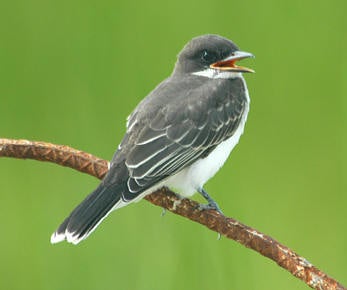SCIENTIFIC NAME:
Tyrannus tyrannus
STATUS:
Breeder. Common in spring, summer, and fall in all regions. Low Conservation Concern.
DESCRIPTION:
The Eastern kingbird is a medium- sized songbird that is dark black to grey-black on the head and back with white coloration on the throat, chest, and belly. The tail of the eastern kingbird is dark colored with a white terminal band. Though rarely visible, eastern kingbirds have a red crown patch on the head. Adult sexes are similar in plumage. Juvenile kingbirds are brownish-grey above, with darker colored under parts than adults. Long crown feathers and an upright posture give the eastern kingbird a distinct silhouette. Overall size ranges from seven to nine inches with a 13-15 inch wingspan. Overall weight ranges from one to two ounces.
DISTRIBUTION:
The Eastern kingbird is a common and widespread species, despite its name. The range of the kingbird extends from the Atlantic to the Pacific Coast. Breeding range extends from British Columbia across Canada and south to Northern California, Central Texas, the Gulf Coast, and Florida. This species migrates to the tropics to spend the winter.
HABITAT:
Typical habitat for the Eastern kingbird includes open country, farmlands, and suburban regions. Eastern kingbirds are often seen perched on utility poles, wires, or at the very top of trees.
FEEDING HABITS:
The summer diet of the Eastern kingbird consists mostly of insects, including wasps, flies, beetles, caterpillars, boll weevils, and mosquitoes. During the winter in the tropics, their diet changes to include small quantities of fruits and berries.
LIFE HISTORY AND ECOLOGY:
Nesting of the Eastern kingbird usually occurs in May. The open cup nest is constructed of grass, weed stems, and lined with soft materials like grass, hair, rootlets, or flowers. Nests are built from eight to 25ft above the ground in trees or on utility structures. The female lays three to five eggs that are white, cream, or pinkish and mottled with shades of brown and lavender. Incubation occurs for 16-18 days and is primarily done by the female. Young fledge at 16-18 days of age, but are often dependent on their parents for more than 5 additional weeks. Both males and females aggressively and fearlessly defend the nest and surrounding area from any intruders regardless of size.
REFERENCE:
http://www.birds.cornell.edu/AllAboutBirds/BirdGuide/Eastern_Kingbird.html
AUTHOR:
Chris Jaworowski, Wildlife Biologist, Alabama Division of Wildlife and Freshwater Fisheries






